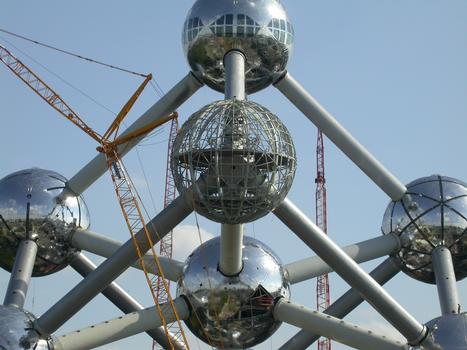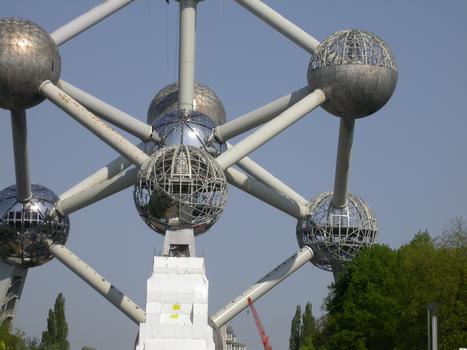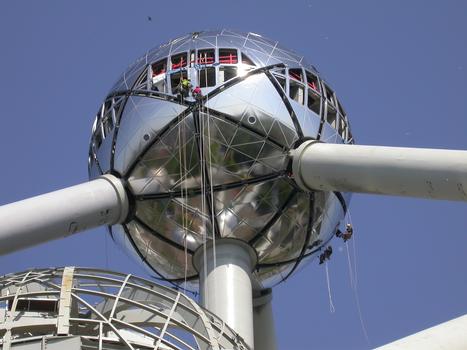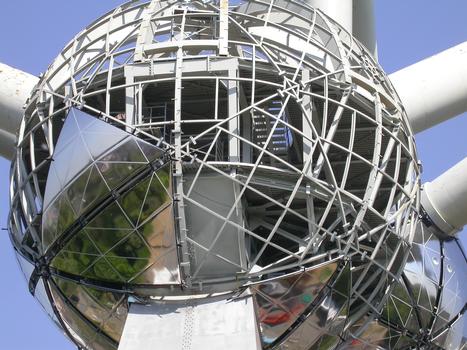General Information
| Other name(s): | Brussels World’s Fair |
|---|---|
| Beginning of works: | 17 April 1958 |
| Completion: | 19 October 1958 |
| Status: | finished |
Project Type
| Event type: |
World's fair |
|---|
Location
| km | Name |
Technical Information
There currently is no technical data available.
Excerpt from Wikipedia
Expo 58, also known as the Brussels World’s Fair (Dutch:Brusselse Wereldtentoonstelling, French:Exposition Universelle et Internationale de Bruxelles), was held from 17 April to 19 October 1958. It was the first major World Expo registered under the Bureau International des Expositions (BIE) after World War II.
Background
Nearly 15,000 workers spent three years building the 2 km² (490 acres) site on the Heysel plateau, 7 kilometres (4.3 mi) northwest of central Brussels, Belgium. Many of the buildings were re-used from the Brussels International Exposition of 1935, which had been held on the same site.
Every 25 years starting in 1855, Belgium had staged large national events to celebrate its national independence following the Belgian Revolution of 1830. However, the Belgian government under prime minister Achille Van Acker decided to forego celebrations in 1955 to have additional funding for the 1958 Expo.
Expo 58 was the 11th World's Fair hosted by Belgium, and the fifth in Brussels, following the fairs in 1888, 1897, 1910 and 1935. Since Expo 58, Belgium has not arranged any more world fairs.
Exhibition
The site is best known for the Atomium, a giant model of a unit cell of an iron crystal (each sphere representing an atom). More than 41 million visitors visited the site, which was opened with a call for world peace and social and economic progress, issued by King Baudouin I.
Notable exhibitions include the Philips Pavilion, where "Poème électronique", commissioned specifically for the location, was played back from 425 loudspeakers, placed at specific points as designed by Iannis Xenakis, and Le Corbusier.
Human zoo
Another exhibition at the Belgian pavilion was the Congolese village that some have branded a human zoo.
The Ministry of Colonies built the Congolese exhibit, intending to demonstrate their claim to have "civilized" the "primitive Africans." Native Congolese art was rejected for display, as the Ministry claimed it was "insufficiently Congolese." Instead, nearly all of the art on display was created by Europeans in a purposefully primitive and imitative style, and the entrance of the exhibit featured a bust of King Leopold II, under whose colonial rule millions of Congolese died. The 700 Congolese chosen to be exhibited by the Ministry were educated urbanites referred to by Belgians as évolués, meaning literally "evolved," but were made to dress in "primitive" clothing, and an armed guard blocked them from communicating with white Belgians who came to observe them. The exotic nature of the exhibit was lauded by visitors and international press, and even the Belgian socialist newspaper Le Peuple praised the portrayal of Africans, saying it was "in complete agreement with historical truth." However, in mid-July the Congolese protested the condescending treatment they were receiving from spectators and demanded to be sent home, abruptly ending the exhibit and eliciting some sympathy from European newspapers.
National pavilions
Austria
The Austrian pavilion was designed by Austrian architect Karl Schwanzer in modernist style. It was later transferred to Vienna to host the museum of the 20th century. In 2011 it was reopened under the new name 21er Haus. It included a model Austrian Kindergarten, which doubled as a day care facility for the employees, the Vienna Philharmonic playing behind glass, and a model nuclear fusion reactor that fired every 5 minutes.
Czechoslovakia
Czechoslovakian pavilon was relocated to Prague, the restaurant works since 2001 as an office space (the main pavilon in other location destroyed 1991 by fire).
The exposition "One Day in Czechoslovakia" was designed by Jindřich Santar who cooperated with artists Jiří Trnka, Antonín Kybal, Stanislav Libenský and Jan Kotík. Architects of the simple, but modern and graceful construction were František Cubr, Josef Hrubý and Zdeněk Pokorný. The team's artistic freedom, so rare in the hard-line communist regime of the 1950s, was ensured by the government committee for exhibitions chairman František Kahuda. He supported the famous Laterna Magika show, as well as Josef Svoboda's technically unique Polyekran. The Czechoslovak pavilion was visited by 6 million people and was officially awarded the best pavilion of the Expo 58.
Mexico
This was designed by the architect Pedro Ramírez Vázquez. It was awarded the exposition's star of gold.
Paris
The city of Paris had its own pavilion, separate from the French one.
United Kingdom
This was produced by the designer James Gardner, architect Howard Lobb & engineer Felix Samuely. The on-site British architect was Michael Blower, Brussels born and bilingual.
USSR
The Soviet pavilion was a large impressive building which they folded up and took back to Russia when Expo 58 ended. They had a facsimile of Sputnik which mysteriously disappeared, and they accused the US of stealing it. They had a bookstore selling science and technology books in English and other languages published by the Moscow Press. On the exposition there was also a model of Lenin the first nuclear icebreaker, and cars: GAZ-21 Volga, GAZ-13 Chaika, ZIL-111, Moskvitch 407 and 423, trucks GAZ-53 and MAZ-525. The Soviet exposition was awarded with a Grand Prix.
USA
The US pavilion was quite spacious and included a fashion show with models walking down a large spiral staircase, an electronic computer that demonstrated a knowledge of history, and a color television studio behind glass. It also served as the concert venue for performance by the Seventh Army Symphony Orchestra under the direction of Edward Lee Alley. It was designed by architect Edward Durell Stone. It would also play host to the University of California Marching Band which had financed its own way to the fair under the direction of James Berdahl.
Federal Republic of Germany
The West German pavilion was designed by the architects Egon Eiermann and Sep Ruf. The world press called it the most polished and sophisticated pavilion of the exhibition.
Yugoslavia
The pavilion of Yugoslavia was designed by the architect Vjenceslav Richter, who originally proposed to suspend the whole structure from a giant cable-stayed mast. When that proved too complicated, Richter devised a tension column consisting of six steel arches supported by a pre-stressed cable, which stood in front of the pavilion as a visual marker and symbolized Yugoslavia's six constituent republics. Filled with modernist art, the pavilion was praised for its elegance and simplicity and Richter was awarded as Knight of the Order of the Belgian Crown. After the end of Expo 58, the pavilion was sold and reconstructed as a school in the Belgian municipality of Wevelgem, where it still stands.
Text imported from Wikipedia article "Expo 58" and modified on May 27, 2020 according to the CC-BY-SA 4.0 International license.
Participants
Currently there is no information available about persons or companies having participated in this project.
Relevant Web Sites
Relevant Publications
- À l'Exposition de Bruxelles 1958. In: Acier = Stahl = Steel, v. 23 (October 1958), pp. 410.
- (1958): L'Architecture à l'Exposition de 1958. In: Acier = Stahl = Steel, v. 23 (July 1958), pp. 290-292.
- (2006): L'Architecture moderne à l'Expo 58. 'Pour un monde plus humain'. Mercator/Dexia, Brussels (Belgium).
- (1983): Architektur der Weltausstellungen. Kohlhammer, Leipzig (Germany), pp. 226.
- L'Atomium à l'Exposition de Bruxelles 1958. In: Acier = Stahl = Steel, v. 23 (July 1958), pp. 300.
- About this
data sheet - Structure-ID
10000032 - Published on:
01/09/2000 - Last updated on:
23/02/2022













